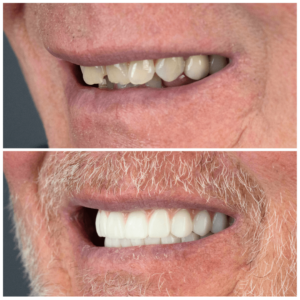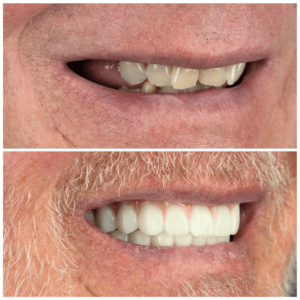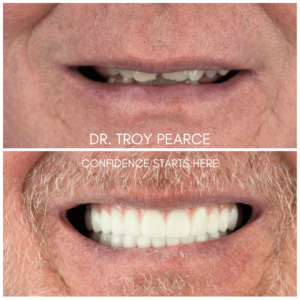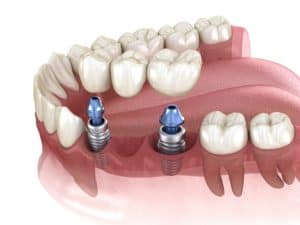Dental Implants Serving Cincinnati, OH
Dental Implants Restore your smile at Pearce Dental Group
Whether you are missing a single tooth or an entire row of teeth, dental implants may be the perfect solution to help you restore a full, attractive smile. Implants help recreate the natural appearance and function of real teeth, and provide a solid foundation for optimal dental health with results that last a lifetime. At Pearce Dental Group, our implant dentist is highly-trained and has helped many patients complete their smiles with dental implants.
What Is a Dental Implant?
A dental implant is an artificial tooth designed to look exactly like a natural tooth. Unlike dentures, implants are securely anchored in your mouth by a strong titanium post, which acts as the “root” of an artificial tooth.
Candidates for Dental Implants
You could be a great candidate for dental implants if you are in good overall health with a healthy mouth. Dental implants require a strong jawbone and healthy gum tissue, and any concerns with your oral health will need to be addressed before we replace one or more missing teeth with a dental implant. Candidates should not have medical conditions or habits that may impact the safety and efficacy of dental implants and the healing process, such as uncontrolled diabetes and smoking.
Dr. Pearce is a skilled implant dentist who can determine if a dental implant is the best option for you and your smile.
Dental Implant Benefits
Dental implants offer benefits that no other tooth replacement solution can, including durability that lasts a lifetime, completely natural feel and function, improved confidence and enhanced quality of life. Dental implants can also be used as the foundation for implant-supported dentures or All-on-Four implants.
Replacing missing teeth with dental implants avoids facial sagging and jawbone degradation caused by the tooth gaps. Restoring oral health with dental implants lowers gum disease risk and reduces your chances of losing additional teeth.
Types of Dental Implants

The two primary options for dental implants are endosteal and subperiosteal implants.
- Endosteal implants are cylinders, blades or screws placed in the jawbone surgically, and the implant may hold one prosthetic or multiple artificial teeth. These are often used for single tooth dental implants, implant-supported bridges and implant-supported dentures.
- Subperiosteal means “on the bone” and is used when there is insufficient bone height to accommodate an endosteal implant. The subperiosteal implant is positioned on the jawbone using a metal post that stretches through the gum tissue to secure the implant.
There are also some less-commonly used types of dental implants. Transosseous dental implants provide a root formation for four missing teeth and can be used when atrophy has affected the lower jaw, making it too thin for traditional dental implants. Zygomatic dental implants may be an alternative to a bone graft and extend deeper into the bone of the upper jaw, anchoring the post into the cheekbone.
Bone Grafts for Dental Implants
When you lose a single tooth, your jawbone may resorb up to 25 percent in the first year. People missing multiple teeth are especially at risk of bone loss in their jaw. In these cases, a bone graft may be needed to create a scaffolding that strengthens the jawbone and readies it for a dental implant.
You may require a bone graft before getting dentures or if you have a tooth extracted. The material for the procedure may be taken from another area of your body, or Dr. Pearce may recommend using donor tissue from a human tissue bank or an animal tissue bank. Synthetic bone graft materials are another option.
If you require a bone graft before your dental implant procedure, you must wait until the area has completely healed.
Dental Implant Consultation

Once Dr. Pearce has a detailed understanding of your oral health, medical history and needs, he will discuss treatment options, including dental implants. Make sure to ask your questions during your consultation as Dr. Pearce dives into the procedure details, such as how many appointments are needed, anesthesia or sedation choices, recovery and results.
Dental Implant Procedure
The implant itself is a man-made artificial root that is placed deep into your gum tissue to replace the natural weakened tooth root. Over the span of a few months, it fuses permanently with your jawbone to replace missing tooth roots. This stimulation also supports the jaw bone and protects the structure of your face.
An abutment is attached to the titanium screw to connect the screw and your custom-made crown. The crown is the portion seen and felt as your tooth, so each crown is customized to mimic the appearance and function of a real tooth.
Dental Implant Timeline
The process of receiving dental implants typically requires several months. There are a number of stages, including periods of healing. Once the titanium screws are implanted in the jaw, the new artificial roots need time to fuse with the bone. Later, a customized artificial tooth will be affixed to the top of the post. Sometimes additional procedures such as bone grafting are required, extending the timeline.
The process of dental implants begins with removal of the natural tooth. Often we are able to place the implant in this site on the same day. If possible, this can reduce the time of healing by half, usually 4-6 months. If the area has infection or has been depleted by bone loss, a graft may be required to strengthen the area. The first stage of the implant usually only takes a day or two.
The following appointments for the implant are usually much less invasive and are tolerated very well. Approximately 75 percent of our implants are placed with just local anesthetic, but we also offer nitrous oxide (laughing gas) and oral sedation to aid in patient comfort.
Risks and Safety Information on Dental Implants
Dental implants have been used for decades and are safe and effective. However, every medical procedure comes with risks. You can reduce your chances of dental implant complications by picking a skilled prosthodontist with additional years of training and education, such as Dr. Pearce. He will review your medical history and determine if dental implants are a good option for your oral health.
Overall, dental implant complications are rare and can often be treated easily. These risks include infection and trauma to surrounding tissues and structures. Nerve damage may occur, such as tingling, numbness or pain in the surrounding teeth, lips, gums or chin. Some patients may experience sinus problems with dental implants in the upper jaw that extend into the sinus cavities. However, these risks are mitigated by choosing an experienced implant dentist, such as Dr. Pearce.
Dental Implant Recovery
Some discomfort is expected after dental implant surgery. The procedure is performed in stages and may have an additional recovery period if bone grafting is involved. Dr. Pearce will provide recovery instructions after each appointment, as well as options for pain relief. These issues may include some bleeding and pain where the implant was placed. Facial swelling and swollen gums or bruised tissues may occur. Stitches typically dissolve on their own but may need to be removed later on.
Antibiotics or pain medications may be necessary after a dental implant procedure. Stick with eating soft foods that are easy on your mouth and palate while you heal. If you experience worsening pain or swelling after oral surgery, contact Pearce Dental Group immediately to prevent complications and ensure you’re healing as expected.
Implant Results & How to Take Care of Them

Unlike dentures, you won’t have to worry about the embarrassment of slippage. And unlike dentures, your jaw benefits from the stimulation of the titanium posts, which preserve the integrity of the jaw bone with the same type of stimulation natural roots provide. This is an extremely important benefit, for without this natural stimulation your bone will atrophy, changing the look of your jaw and your entire facial profile.
A 2017 study shows dental implants have a 90 to 95 percent success rate over 10 years. When you will see dental implant results depends on your circumstances, as some patients must have a bone graft to provide enough stability for the implanted post to fuse to the bone.
In rare cases, the titanium post may fail to merge with the jawbone. Implant failure is more common in smokers because smoking inhibits the healing process. The dental implant is removed in these cases, and we may attempt the procedure again three months later.
Dental implants can last a lifetime with proper oral hygiene, regular dental exams and teeth cleanings.


Cost of Dental Implants
The cost of your dental implant procedure will vary from the next patient because there are personal considerations. The type of implant, whether you need a bone graft or tooth extraction, and the material of the implant, abutment and dental crown will impact your price estimate.
The price range for a single dental implant can range from $3,500 to $6,700, but this cost will be higher for implant-supported bridges and dentures.
During your dental exam and consultation at our Cincinnati office, we can provide you with a cost estimate for your restorative dentistry work and may help you with financing options.
Dental Implant Alternatives
Dental implants are the ideal cosmetic dental procedure to restore oral health and mouth function. However, some patients may wish for alternative options due to comfort or cost. Dental bridges are a popular alternative that “bridge” the gap left by a missing tooth using dental crowns placed on the teeth on either side of the space. A “pontic” or artificial tooth fills the hole, and the dental crowns hold it in place. The adjacent teeth must be healthy and strong to support a dental bridge.
Those missing multiple teeth may be interested in partial dentures or implant-supported dentures. An entire arch can be restored with full dentures or implant-supported dentures.
Dental Implant FAQs
Is the Dental Implant Process Painful?
You will likely experience some discomfort after your dental implant procedure, but short-term pain medications and over-the-counter drugs can help you manage this discomfort while you heal.
Can You Be Too Old for Dental Implants?
No, you cannot be too old for dental implants. Dental implants may be the best way to improve your oral and overall health in your golden years. Dentures can be a nuisance and they don’t stop jawbone resorption.
Implant-supported bridges, implant-supported dentures and All-on-4® dental implants are excellent ways to restore a healthy mouth at any age. You’ll be able to enjoy your favorite foods and laugh, smile and chew without having to think about your dentures slipping.
To learn more about dental implants, schedule an appointment with experienced southwestern Ohio dentist Dr. Troy Pearce by contacting our Cincinnati office today.





